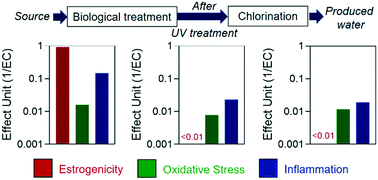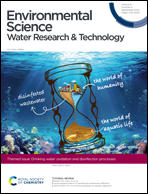Application of in vitro bioassays for water quality monitoring in three drinking water treatment plants using different treatment processes including biological treatment, nanofiltration and ozonation coupled with disinfection†
Abstract
Surface waters feeding water treatment plants (WTPs) can contain organic micropollutants, which are typically removed during treatment, while disinfection by-products (DBPs) can form after disinfection. The complex mixtures of chemicals in drinking water imply that targeted chemical analysis cannot capture all chemicals present, though in vitro bioassays can be applied alongside chemical analysis to monitor the total chemical burden. The current study applied bioassays indicative of hormone receptor-mediated effects to evaluate micropollutant removal during treatment, while bioassays indicative of adaptive stress responses and mutagenicity were applied to assess DBP formation. Water was extracted with solid-phase extraction from three WTPs using different treatment processes including biological treatment, nanofiltration and ozonation. Of the studied hormone receptors, only estrogenic activity was detected in the source waters feeding the WTPs, with all treatment processes able to remove estrogenic activity in the produced water completely or just above the detection limit. The oxidative stress response and NF-κB response for inflammation were detected in both source and treated water samples, with formed DBPs contributing to the increase in oxidative stress response. None of the samples induced the p53 response for genotoxicity or had a response in the Ames mutagenicity assay. The effects in the produced water were compared to effect-based trigger values (EBT) for activation of estrogenic activity and oxidative stress response, with the observed effect over 10 times lower than the available EBTs. This emphasises the high quality of the produced drinking water and the value of applying in vitro bioassays for water quality monitoring.

- This article is part of the themed collections: Drinking water oxidation and disinfection processes and Research from our newest ESPI Editorial Board members


 Please wait while we load your content...
Please wait while we load your content...